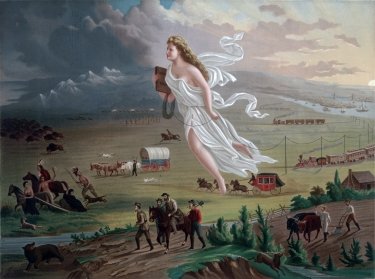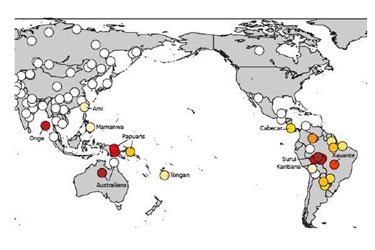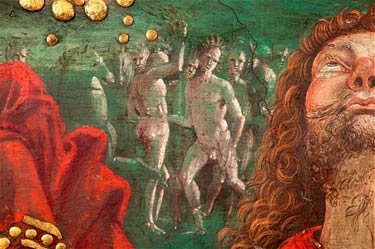Category Archive 'Amerindians'
10 Oct 2022


John Gast, American Progress, 1872, Autry Museum of the American West, Los Angeles, California.
Jeff Fynn-Paul debunks the leftist myth of European guilt.
[N]o matter who ‘discovered’ the New World, it is inevitable that a large proportion of New World inhabitants would have died within the first few decades after first contact. This is universally acknowledged by specialists in the field. The New World population was smaller and more homogenous than the Old World population. Thus, its people had less immunity to disease than the people of the Old World, where disease communities from Africa, Asia and Europe had been intermingling for millennia. Even though some European captains did try and spread smallpox around a few forts and villages from time to time, the effect of their efforts was almost negligible compared with the natural spread of disease. So the claims of genocide by disease have almost nothing to do with European actions, apart from their simply reaching the New World. And of course, Europeans of the time had no way of envisioning the continent-wide epidemic repercussions of their actions. Verdict: not guilty.
Let us also acknowledge that Native American society was just as warlike as any other in human history. The anthropologists’ vision of Native Americans as peace-pipe-smoking environmentalists which gained purchase in the 1970s has long since given way to a more Hobbesian portrait of pre-Columbian reality. In North America, most Natives were primitive farmers. This means that (with some exceptions) they had no permanent settlements: they farmed in an area for a few decades until the soil got tired, before moving on to greener pastures where the hunting was better and the lands more fertile. This meant that tribes were in constant conflict with other tribes. It also meant that chiefs were continually vying for power, creating confederations under themselves, and that the question of who owned the land was in a more or less constant state of flux. In most of North America, the idea that any one piece of land belonged to any one tribe, for more than 50 or 100 years, is therefore highly questionable. In short, if you looked at a map of Native Canada 200 years before Europeans arrived, it would have been entirely different. In the meantime, some groups of natives would have slaughtered, bullied or enslaved others. Should we not be grieving for those Native Canadians whose land was stolen by other Native Canadians? Or is that somehow OK? I don’t suppose there is an app for that.
The idea that the Europeans stole some land which had belonged in perpetuity to any one tribe is therefore ludicrous. The situation in most of North America was similar to northern Europe on the eve of the Germanic migrations, or western Europe as the Celts were moving across the landscape. Precisely to whom the land belonged in any given century at these periods in history was anyone’s guess. The very notion of property is a Greco-Roman invention which most cultures found foreign until quite recently. But Europeans of the time had little chance of grasping this difference. What the Europeans did in the New World was insert themselves into a fluid power struggle which had been ongoing for millennia. Many Native American chiefs were ready to pledge allegiance to the Great ‘Chief of the English’, as a political expedient, just as various English colonies sided with this or that Native American ‘Great Chief’. Despite a few sensational cases of duplicity, most of the time, Europeans tried to buy land from Indians, just like they would buy an acre of land in England. If the local chief assented to this and liked the price, where then was the crime? Many individual Europeans believed that according to the norms of both parties, they had legal usufruct to the land they were working. To judge this as theft is therefore anachronistic. As Europeans set up farming communities, and introduced guns to North America, Native American communities were forced to move further away from European lands as game retreated. The areas around white settlements were often empty for this reason, making the land seem all the more abandoned. Musket use by natives probably depleted animal stocks at a higher rate than previously, meaning that the very introduction of firearms might have spelled the doom of hunting and gathering in North America in the long run, even if the Europeans had otherwise left the country alone.
Another major structural issue is this: what precisely would our pious anthropology professors have had Europeans do with the New World once they found it?
This is not a joke. Political reality has a way of crashing in on the pipe dreams of liberal academics. The reality is, if the English had not colonized, then the French or the Dutch would have. If the Spanish had not colonized, the Portuguese would have. This would have shifted the balance of power at home, and any European country which had not colonized, would have been relegated to secondary status. And it is easy to overestimate the amount of control that European governments actually had. As soon as the New World was discovered, many fisherman and traders sailed across the Atlantic on their own, in hopes of circumventing tax authorities and scoring a fortune. Long before colonies were established in most regions, the New World was crawling with Europeans whose superior technology gave them an edge in combat. Nonetheless, it was extremely dangerous for Europeans to provoke fights with Native Americans, and most of them tried to avoid this when possible. In retrospect, one could in theory be impressed that so many European governments showed a genuine concern to rein in the worst excesses of their subjects, with an express eye to protecting the Indians from depredation. The logic was simple: they attempted to protect their subjects at home, in order to secure good order and a better tax base. So they would do the same to their subjects in the New World. For a long time, few Europeans harbored any master plan of pushing the Native Americans out of their own lands. In more densely populated regions such as Mexico, such an idea must have seemed an absurdity. Reality tends to occur ad hoc. Boundaries often took generations to move, and would have seemed fixed at the time. For several centuries, many Europeans assumed that they would long be a minority on the North American continent. In Mexico and Peru, they always have been.
RTWT
I think it is worth noting that none of those sanctimonious lefties telling Americand and Canadians that they are residing on land rightfully belonging to this or that “First People” tribe can be seen packing their bags and hopping on a plane back to Europe.
24 Jul 2015


The Register describes the findings of genetic research reported in a paper in Nature, titled “Genetic evidence for two founding populations of the Americas.”
A long-vanished race of humans, whose descendants now survive only among certain indigenous peoples in Australasia and in the Amazon jungles, may have been the true, original Native Americans, according to new genetics research.
The clue to the existence of this mysterious “Population Y” has been found by boffins probing the genes of various native-American peoples. Amazingly, the researchers found that a couple of tribes in the Amazon jungle actually had quite a lot in common genetically with others in Australia, New Guinea and the Andaman Islands.
It’s well known, of course, that humanity spread from its original cradle in Africa out across Asia and thus south to Australasia and separately north – via the Bering Strait land bridge, then in existence – to North America.
The first emigrants across the Bering were the First Americans. What’s not totally clear is exactly when they arrived, how many of them there were, what other groups arrived at what point etc. Given that they were arriving via a travel route just south of the ice sheets which then covered a lot of the northern globe, it’s generally thought that they didn’t come in a continuous stream, but more probably in waves when conditions were favourable.
One widely-held theory has it that the First Americans arrived in one wave of fairly genetically similar people, and this theory fitted pretty well with the observed genetics of native-American people both North and South. But the Amazon-Australasia linkage has pretty much upset that applecart.
“We spent a really long time trying to make this result go away and it just got stronger,” says Professor David Reich of the Harvard Medical School.
Read the whole thing.
Unmentioned besides is a possible third group, the Solutrean Hypothesis, a theory based on archaeological evidence which proposes also some Trans-Atlantic settlement of the Americas.
03 Mar 2015


The gorget found February 13, 2015, in Newtown, Ohio is engraved with an image that appears to be half bird and half cat.
WVXU reports the recent discovery of a rare Native American pendant dating to the 5th Century A.D. in Ohio. Only 8 examples of the same style and period have ever been found.
Contractors digging a trench for a fiber optic box north of Newtown’s administrative hall earlier this month found human remains. They called police who quickly realized it was a burial site and not a crime scene. They, in turn, called the Cincinnati Museum Center. …
“When the police department actually called us, when I talked to them, he said they found some human remains and he said there was a plate with it. And I kind of knew exactly what he meant because we had found these other two back in 1981,†says Rieveschl Curator for Archeology Bob Genheimer.
Genheimer says the plate is actually a gorget, a decorative seashell, with the image of an animal carved on it.
“A gorget is an ornamental item. These gorgets have three holes in them. They have two at the top for suspension and there’s one in the middle where they possibly could have been attached to clothing or something else,†he says. “And on the inside, they are engraved.â€
Two other gorgets found in Newtown had images of an opossum and a panther carved on them. This one had a hybrid: part bird, part cat.
“Anywhere else in the world, you would refer to this as a griffin. But that’s not something that’s very viable in the Americas.
“We believe that the bird may be a Carolina Parakeet. Which, as many people know, is now an extinct bird, but used to be prevalent in the southern United States and as far north as here,†Genheimer says.
16 Aug 2014


Flaked blade recovered from Chesapeake Bay.
Business Insider describes one of the North American finds strikingly resembling Solutrean tools from Western Europe, which suggest the possibility of some Paleolithic settlement of North America from Europe.
Most researchers believe the first Americans crossed the Bering Strait from Siberia about 15,000 years ago and quickly colonized North America. Artifacts from these ancient settlers, dubbed the Clovis culture after one of their iconic archaeological sites in Clovis, New Mexico, have been found from Canada to the edges of North America.
But in 1974, a small wooden scallop trawler was dredging the seafloor, about 230 feet (70 meters) below the sea surface and nearly 60 miles (100 kilometers) off the coastline in the Chesapeake Bay.
“They hit a snag, or a hang, as they like to say, which meant that something pretty heavy was in their net,” said Dennis Stanford, an archaeologist with the Smithsonian Institution in Washington, D.C., who has analyzed the find.
When they pulled up their net, they found the partial skull of a mastodon, a distant cousin of the woolly mammoth that began its slide into extinction about 12,000 years ago, Stanford said. The fishermen also noticed a flaked blade made of a volcanic rock called rhyolite.
The fisherman couldn’t lug the skull back to shore in their tiny wooden boat, so they sawed off the tusks and teeth, tossed the rest overboard and eventually handed portions to the crew as souvenirs. Capt. Thurston Shawn gave the remaining tusk portions, teeth and knife to a relative, who donated the remains to Gwynn’s Island Museum in Virginia. There they sat, unnoticed, for decades.
But while doing his doctoral dissertation, Darrin Lowery, a geologist at the University of Delaware, noticed the teeth and the tusk at the museum. …
By measuring the fraction of radioactive carbon isotopes (elements of carbon with different numbers of neutrons), the team found that the mastodon tusk was more than 22,000 years old.
There was no way to date the blade precisely, but the deft flint-knapping technique used to make it was similar to that found in Solutrean tools, which were made in Europe between 22,000 and 17,000 years ago.
Melting glaciers raised sea levels and submerged that area of the continental shelf about 14,000 years ago, so the knife must have been at least that old, Stanford added.
In addition, both pieces showed characteristic weathering that indicated they were exposed to the air for a while and then submerged in a saltwater marsh, before finally being buried in seawater.
That finding suggested that the two artifacts were possibly from the same environment — such as the marshes found between sand dunes that are often set back from the seashore. That would have been a perfect place for mastodons to find food, Stanford said.
“They like to chew on bushes and more rough shrubbery,” Stanford said.
To Stanford, Lowery and their colleagues, the discoveries suggest that people lived along the East Coast more than 14,000 years ago — potentially thousands of years before the Clovis culture emerged there. These first American colonizers may have even crossed the Atlantic Ocean from Europe, Stanford said.
Read the whole thing.
The problem with the theory of Solutrean settlement is that, so far, at least, DNA studies argue against the hypothesis.
03 May 2013

Bernardino di Betto, called Pintoricchio or Pinturicchio, Detail from The Resurrection, 1494, Musei Vaticani
Restoration of a painting of the Resurrection of Christ by Pinturicchio, commissioned by Pope Alexander VI to ornament his Papal apartments found that the painting’s background features “nude men, who are decorated with feathers and seem to be dancing.”
Antonio Paolucci, the director of the Vatican Museums, announced that these figures have been recognized as representations of Native Americans which were painted on the basis of their description by Christopher Columbus in 1494, in the direct aftermath of his first voyage of discovery to the New World.
The painting had been long neglected because of the unsavory character of Rodrigo Borgia (Alexander VI). Subsequent popes closed and abandoned his apartments, which were only re-opened for the first time after his death in 1503 in 1889 by Pope Leo XIII.
Telegraph story.
Via the Dish.
Your are browsing
the Archives of Never Yet Melted in the 'Amerindians' Category.

Feeds
|








